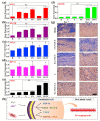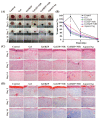A Review on Hydrogels with Photothermal Effect in Wound Healing and Bone Tissue Engineering
- PMID: 34202237
- PMCID: PMC8271463
- DOI: 10.3390/polym13132100
A Review on Hydrogels with Photothermal Effect in Wound Healing and Bone Tissue Engineering
Abstract
Photothermal treatment (PTT) is a promising strategy to deal with multidrug-resistant bacteria infection and promote tissue regeneration. Previous studies demonstrated that hyperthermia can effectively inhibit the growth of bacteria, whereas mild heat can promote cell proliferation, further accelerating wound healing and bone regeneration. Especially, hydrogels with photothermal properties could achieve remotely controlled drug release. In this review, we introduce a photothermal agent hybrid in hydrogels for a photothermal effect. We also summarize the potential mechanisms of photothermal hydrogels regarding antibacterial action, angiogenesis, and osteogenesis. Furthermore, recent developments in photothermal hydrogels in wound healing and bone regeneration applications are introduced. Finally, future application of photothermal hydrogels is discussed. Hydrogels with photothermal effects provide a new direction for wound healing and bone regeneration, and this review will give a reference for the tissue engineering.
Keywords: angiogenesis; antibacterial; bone regeneration; hydrogel; photothermal effect; wound healing.
Conflict of interest statement
The authors declare no conflict of interest.
Figures







Similar articles
-
Polysaccharide-based hydrogel with photothermal effect for accelerating wound healing.Carbohydr Polym. 2023 Jan 1;299:120228. doi: 10.1016/j.carbpol.2022.120228. Epub 2022 Oct 15. Carbohydr Polym. 2023. PMID: 36876827 Review.
-
Novel Photothermal Graphene-Based Hydrogels in Biomedical Applications.Polymers (Basel). 2024 Apr 15;16(8):1098. doi: 10.3390/polym16081098. Polymers (Basel). 2024. PMID: 38675017 Free PMC article. Review.
-
Photothermal Hydrogels for Promoting Infected Wound Healing.Macromol Biosci. 2023 Feb;23(2):e2200378. doi: 10.1002/mabi.202200378. Epub 2022 Nov 16. Macromol Biosci. 2023. PMID: 36337010 Review.
-
Adhesive Hemostatic Conducting Injectable Composite Hydrogels with Sustained Drug Release and Photothermal Antibacterial Activity to Promote Full-Thickness Skin Regeneration During Wound Healing.Small. 2019 Mar;15(12):e1900046. doi: 10.1002/smll.201900046. Epub 2019 Feb 20. Small. 2019. PMID: 30786150
-
Muscle-inspired MXene/PVA hydrogel with high toughness and photothermal therapy for promoting bacteria-infected wound healing.Biomater Sci. 2022 Feb 15;10(4):1068-1082. doi: 10.1039/d1bm01604k. Biomater Sci. 2022. PMID: 35037673
Cited by
-
Biodegradable Hydrogel Beads Combined with Calcium Phosphate Bone Cement for Bone Repair: In Vitro and In Vivo Characterization.Polymers (Basel). 2022 Jan 27;14(3):505. doi: 10.3390/polym14030505. Polymers (Basel). 2022. PMID: 35160495 Free PMC article.
-
Effect of Micro-/Nanoparticle Hybrid Hydrogel Platform on the Treatment of Articular Cartilage-Related Diseases.Gels. 2021 Sep 27;7(4):155. doi: 10.3390/gels7040155. Gels. 2021. PMID: 34698122 Free PMC article. Review.
-
Modern Wound Dressings: Hydrogel Dressings.Biomedicines. 2021 Sep 16;9(9):1235. doi: 10.3390/biomedicines9091235. Biomedicines. 2021. PMID: 34572421 Free PMC article. Review.
-
Toward Autonomous Self-Healing in Soft Robotics: A Review and Perspective for Future Research.Adv Intell Syst. 2025 Aug;7(8):2400790. doi: 10.1002/aisy.202400790. Epub 2025 Feb 17. Adv Intell Syst. 2025. PMID: 40852089 Free PMC article. Review.
-
Natural Affinity Driven Modification by Silicene to Construct a "Thermal Switch" for Tumorous Bone Loss.Adv Sci (Weinh). 2024 Sep;11(35):e2404534. doi: 10.1002/advs.202404534. Epub 2024 Jul 21. Adv Sci (Weinh). 2024. PMID: 39033540 Free PMC article.
References
-
- Tao N., Liu Y., Wu Y., Li X., Li J., Sun X., Chen S., Liu Y.-N. Minimally Invasive Antitumor Therapy Using Biodegradable Nanocomposite Micellar Hydrogel with Functionalities of NIR-II Photothermal Ablation and Vascular Disruption. ACS Appl. Bio Mater. 2020;3:4531–4542. doi: 10.1021/acsabm.0c00465. - DOI - PubMed
-
- Cahill S.V., Kwon H., Back J., Lee I., Lee S., Alder K.D., Hao Z., Yu K.E., Dussik C.M., Kyriakides T.R., et al. Locally delivered adjuvant biofilm-penetrating antibiotics rescue impaired endochondral fracture healing caused by MRSA infection. J. Orthop. Res. 2021;39:402–414. doi: 10.1002/jor.24965. - DOI - PubMed
-
- Contardi M., Kossyvaki D., Picone P., Summa M., Guo X., Heredia-Guerrero J.A., Giacomazza D., Carzino R., Goldoni L., Scoponi G., et al. Electrospun polyvinylpyrrolidone (PVP) hydrogels containing hydroxycinnamic acid derivatives as potential wound dressings. Chem. Eng. J. 2021;409:128144. doi: 10.1016/j.cej.2020.128144. - DOI
-
- Ahmed R., Afreen A., Tariq M., Zahid A.A., Masoud M.S., Ahmed M., Ali I., Akram Z., Hasan A. Bone marrow mesenchymal stem cells preconditioned with nitric-oxide-releasing chitosan/PVA hydrogel accelerate diabetic wound healing in rabbits. Biomed. Mater. 2021;16:035014. doi: 10.1088/1748-605X/abc28b. - DOI - PubMed
-
- Zhang B., He J., Shi M., Liang Y., Guo B. Injectable self-healing supramolecular hydrogels with conductivity and photo-thermal antibacterial activity to enhance complete skin regeneration. Chem. Eng. J. 2020;400:125994. doi: 10.1016/j.cej.2020.125994. - DOI
Publication types
Grants and funding
LinkOut - more resources
Full Text Sources

